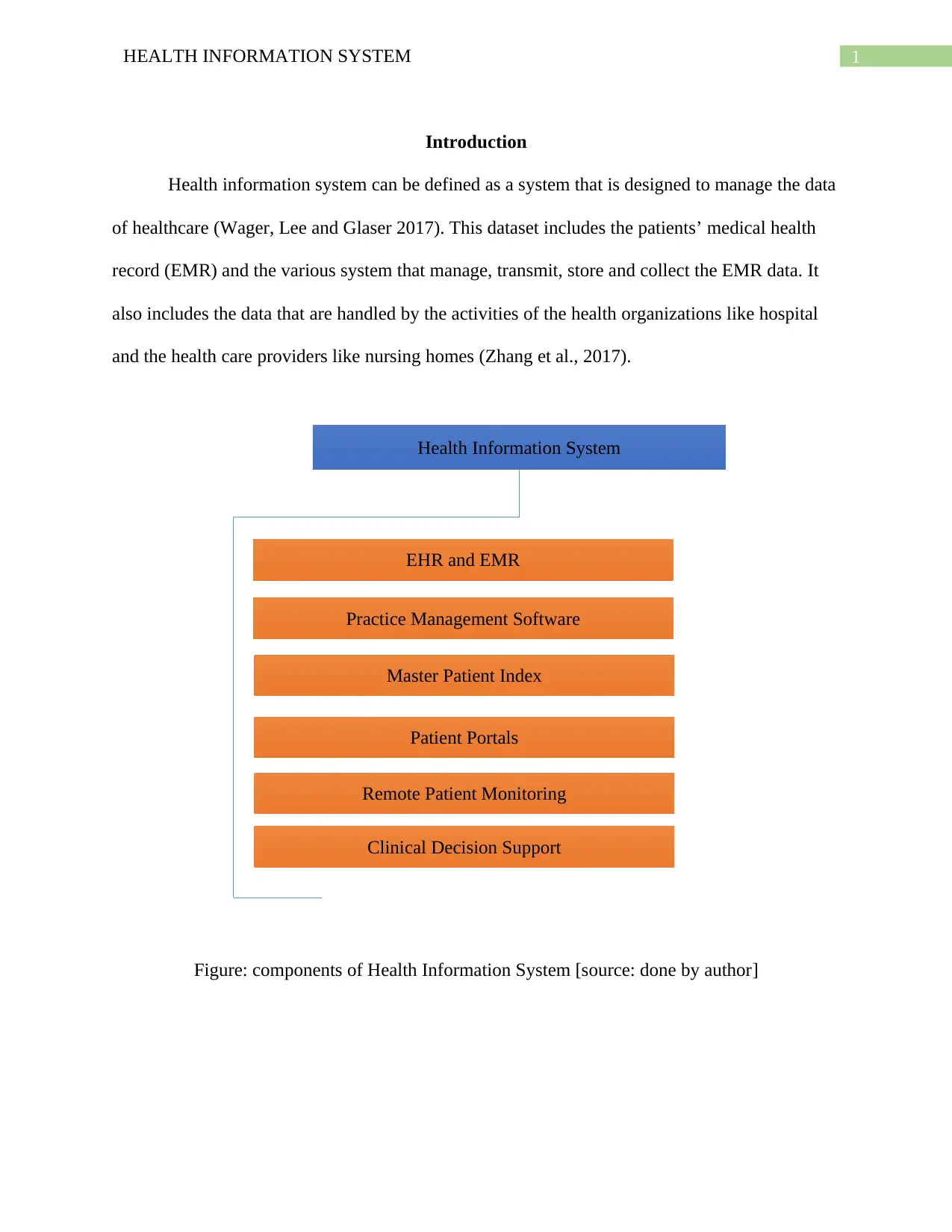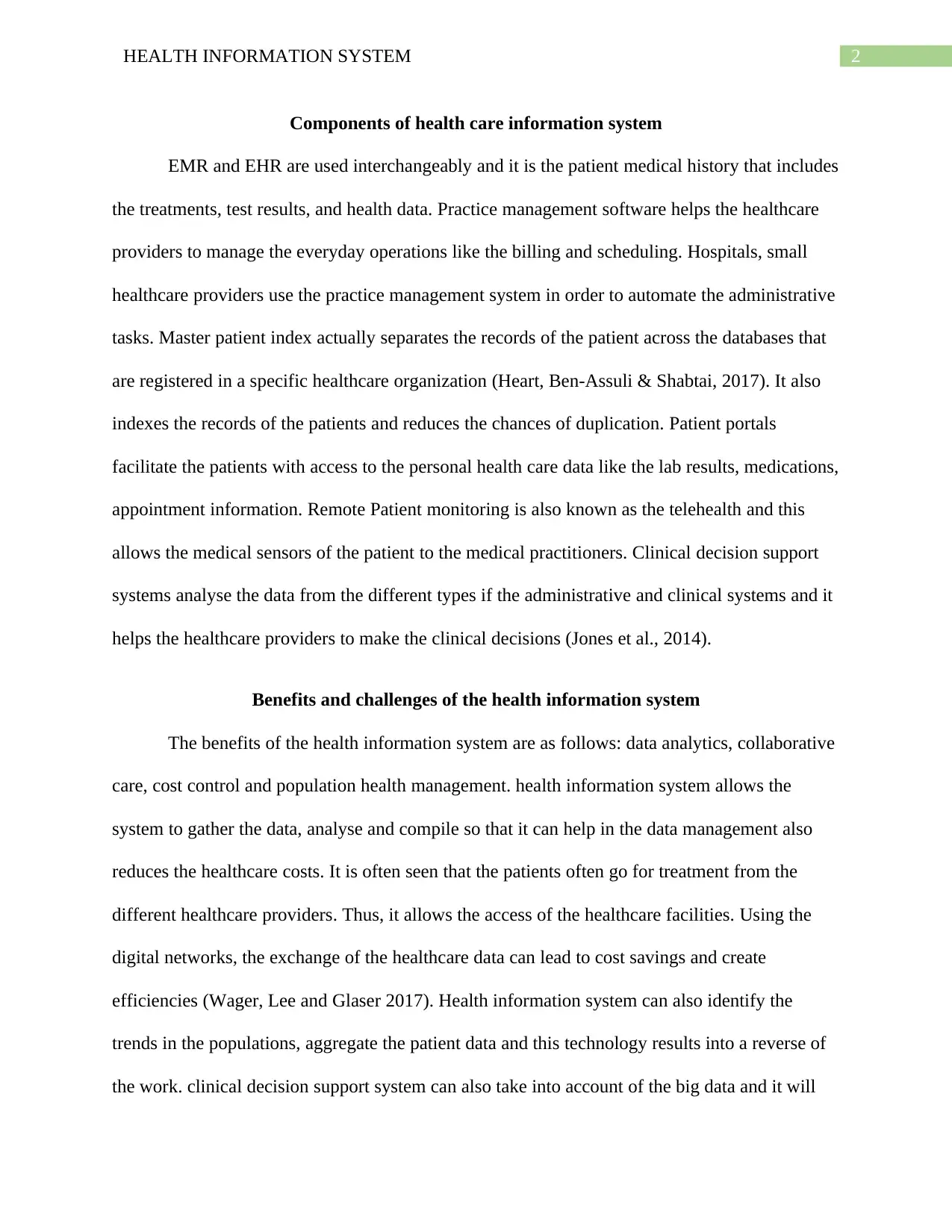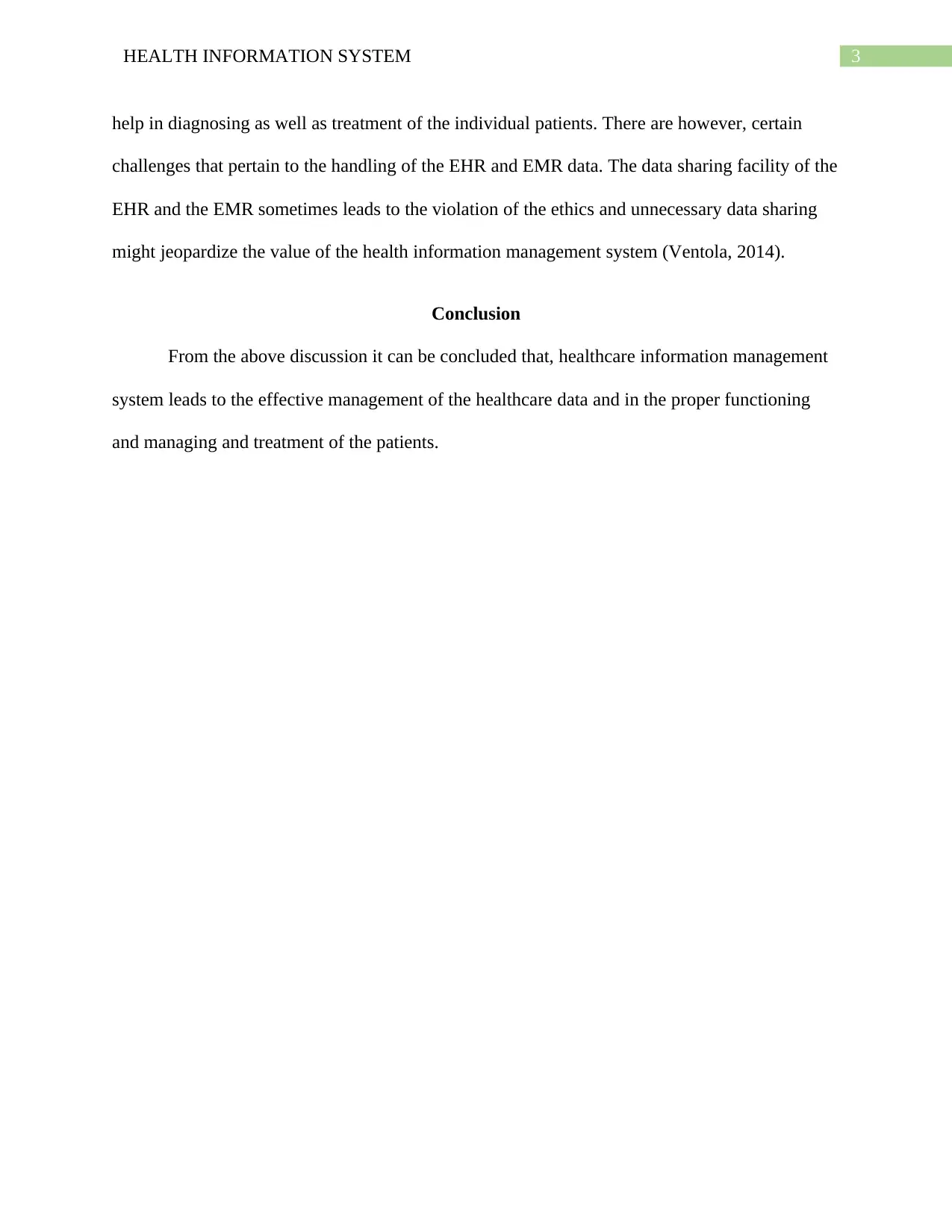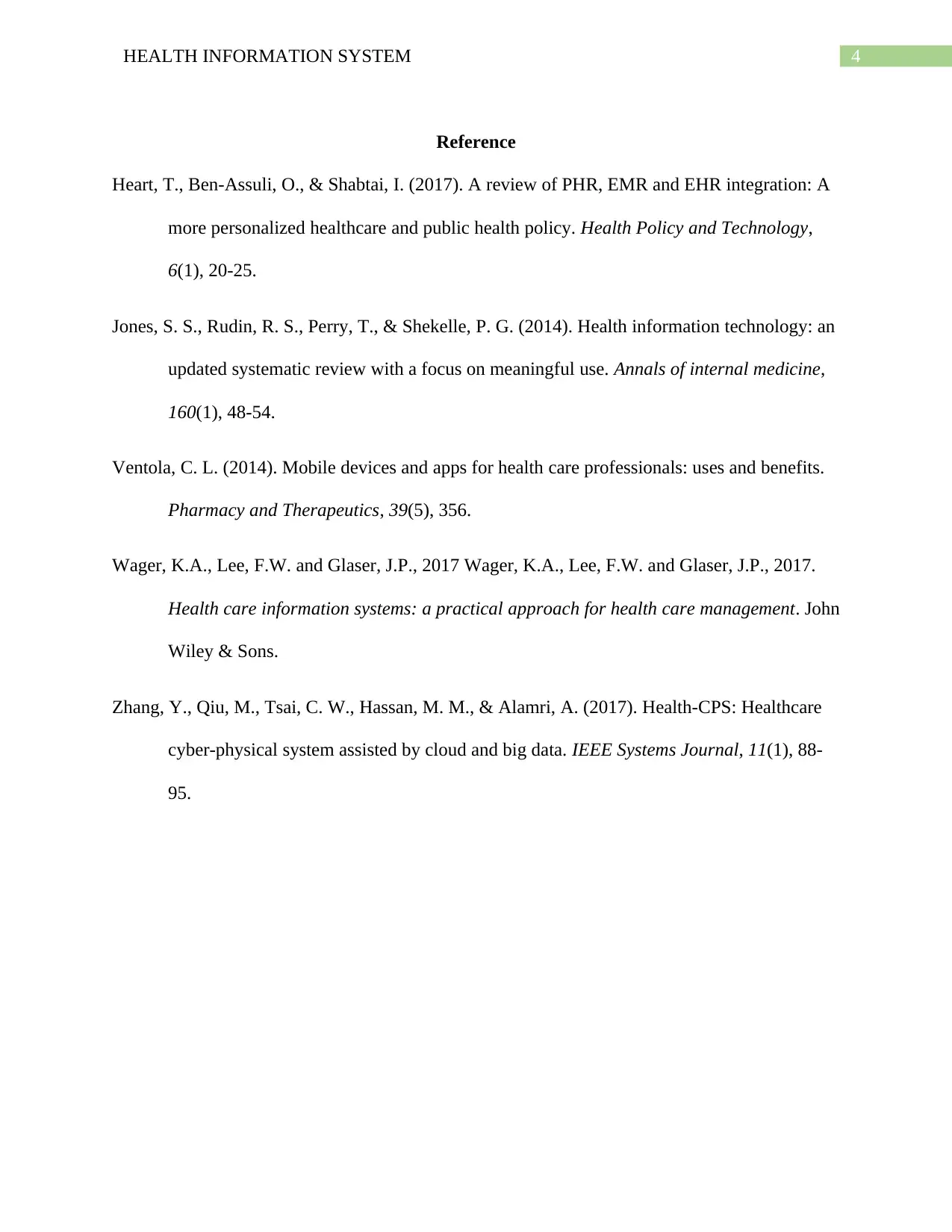Health Information System: Components, Benefits, and Challenges
VerifiedAdded on 2023/01/11
|5
|849
|40
Report
AI Summary
This report provides a comprehensive overview of Health Information Systems (HIS). It defines HIS as a system designed to manage healthcare data, including Electronic Medical Records (EMR) and the various systems that manage, transmit, store, and collect this data. The report details key components such as EMR/EHR, practice management software, master patient index, patient portals, remote patient monitoring, and clinical decision support systems. It outlines the benefits of HIS, including data analytics, collaborative care, cost control, and population health management. The report also addresses challenges related to data sharing and ethical considerations. The conclusion emphasizes the importance of HIS in effective healthcare data management and patient treatment.

Running head: HEALTH INFORMATION SYSTEM
HEALTH INFORMATION SYSTEM
Name of the Student:
Name of the University:
Author Note:
HEALTH INFORMATION SYSTEM
Name of the Student:
Name of the University:
Author Note:
Paraphrase This Document
Need a fresh take? Get an instant paraphrase of this document with our AI Paraphraser

1HEALTH INFORMATION SYSTEM
Health Information System
EHR and EMR
Practice Management Software
Master Patient Index
Patient Portals
Remote Patient Monitoring
Clinical Decision Support
Introduction
Health information system can be defined as a system that is designed to manage the data
of healthcare (Wager, Lee and Glaser 2017). This dataset includes the patients’ medical health
record (EMR) and the various system that manage, transmit, store and collect the EMR data. It
also includes the data that are handled by the activities of the health organizations like hospital
and the health care providers like nursing homes (Zhang et al., 2017).
Figure: components of Health Information System [source: done by author]
Health Information System
EHR and EMR
Practice Management Software
Master Patient Index
Patient Portals
Remote Patient Monitoring
Clinical Decision Support
Introduction
Health information system can be defined as a system that is designed to manage the data
of healthcare (Wager, Lee and Glaser 2017). This dataset includes the patients’ medical health
record (EMR) and the various system that manage, transmit, store and collect the EMR data. It
also includes the data that are handled by the activities of the health organizations like hospital
and the health care providers like nursing homes (Zhang et al., 2017).
Figure: components of Health Information System [source: done by author]

2HEALTH INFORMATION SYSTEM
Components of health care information system
EMR and EHR are used interchangeably and it is the patient medical history that includes
the treatments, test results, and health data. Practice management software helps the healthcare
providers to manage the everyday operations like the billing and scheduling. Hospitals, small
healthcare providers use the practice management system in order to automate the administrative
tasks. Master patient index actually separates the records of the patient across the databases that
are registered in a specific healthcare organization (Heart, Ben-Assuli & Shabtai, 2017). It also
indexes the records of the patients and reduces the chances of duplication. Patient portals
facilitate the patients with access to the personal health care data like the lab results, medications,
appointment information. Remote Patient monitoring is also known as the telehealth and this
allows the medical sensors of the patient to the medical practitioners. Clinical decision support
systems analyse the data from the different types if the administrative and clinical systems and it
helps the healthcare providers to make the clinical decisions (Jones et al., 2014).
Benefits and challenges of the health information system
The benefits of the health information system are as follows: data analytics, collaborative
care, cost control and population health management. health information system allows the
system to gather the data, analyse and compile so that it can help in the data management also
reduces the healthcare costs. It is often seen that the patients often go for treatment from the
different healthcare providers. Thus, it allows the access of the healthcare facilities. Using the
digital networks, the exchange of the healthcare data can lead to cost savings and create
efficiencies (Wager, Lee and Glaser 2017). Health information system can also identify the
trends in the populations, aggregate the patient data and this technology results into a reverse of
the work. clinical decision support system can also take into account of the big data and it will
Components of health care information system
EMR and EHR are used interchangeably and it is the patient medical history that includes
the treatments, test results, and health data. Practice management software helps the healthcare
providers to manage the everyday operations like the billing and scheduling. Hospitals, small
healthcare providers use the practice management system in order to automate the administrative
tasks. Master patient index actually separates the records of the patient across the databases that
are registered in a specific healthcare organization (Heart, Ben-Assuli & Shabtai, 2017). It also
indexes the records of the patients and reduces the chances of duplication. Patient portals
facilitate the patients with access to the personal health care data like the lab results, medications,
appointment information. Remote Patient monitoring is also known as the telehealth and this
allows the medical sensors of the patient to the medical practitioners. Clinical decision support
systems analyse the data from the different types if the administrative and clinical systems and it
helps the healthcare providers to make the clinical decisions (Jones et al., 2014).
Benefits and challenges of the health information system
The benefits of the health information system are as follows: data analytics, collaborative
care, cost control and population health management. health information system allows the
system to gather the data, analyse and compile so that it can help in the data management also
reduces the healthcare costs. It is often seen that the patients often go for treatment from the
different healthcare providers. Thus, it allows the access of the healthcare facilities. Using the
digital networks, the exchange of the healthcare data can lead to cost savings and create
efficiencies (Wager, Lee and Glaser 2017). Health information system can also identify the
trends in the populations, aggregate the patient data and this technology results into a reverse of
the work. clinical decision support system can also take into account of the big data and it will
⊘ This is a preview!⊘
Do you want full access?
Subscribe today to unlock all pages.

Trusted by 1+ million students worldwide

3HEALTH INFORMATION SYSTEM
help in diagnosing as well as treatment of the individual patients. There are however, certain
challenges that pertain to the handling of the EHR and EMR data. The data sharing facility of the
EHR and the EMR sometimes leads to the violation of the ethics and unnecessary data sharing
might jeopardize the value of the health information management system (Ventola, 2014).
Conclusion
From the above discussion it can be concluded that, healthcare information management
system leads to the effective management of the healthcare data and in the proper functioning
and managing and treatment of the patients.
help in diagnosing as well as treatment of the individual patients. There are however, certain
challenges that pertain to the handling of the EHR and EMR data. The data sharing facility of the
EHR and the EMR sometimes leads to the violation of the ethics and unnecessary data sharing
might jeopardize the value of the health information management system (Ventola, 2014).
Conclusion
From the above discussion it can be concluded that, healthcare information management
system leads to the effective management of the healthcare data and in the proper functioning
and managing and treatment of the patients.
Paraphrase This Document
Need a fresh take? Get an instant paraphrase of this document with our AI Paraphraser

4HEALTH INFORMATION SYSTEM
Reference
Heart, T., Ben-Assuli, O., & Shabtai, I. (2017). A review of PHR, EMR and EHR integration: A
more personalized healthcare and public health policy. Health Policy and Technology,
6(1), 20-25.
Jones, S. S., Rudin, R. S., Perry, T., & Shekelle, P. G. (2014). Health information technology: an
updated systematic review with a focus on meaningful use. Annals of internal medicine,
160(1), 48-54.
Ventola, C. L. (2014). Mobile devices and apps for health care professionals: uses and benefits.
Pharmacy and Therapeutics, 39(5), 356.
Wager, K.A., Lee, F.W. and Glaser, J.P., 2017 Wager, K.A., Lee, F.W. and Glaser, J.P., 2017.
Health care information systems: a practical approach for health care management. John
Wiley & Sons.
Zhang, Y., Qiu, M., Tsai, C. W., Hassan, M. M., & Alamri, A. (2017). Health-CPS: Healthcare
cyber-physical system assisted by cloud and big data. IEEE Systems Journal, 11(1), 88-
95.
Reference
Heart, T., Ben-Assuli, O., & Shabtai, I. (2017). A review of PHR, EMR and EHR integration: A
more personalized healthcare and public health policy. Health Policy and Technology,
6(1), 20-25.
Jones, S. S., Rudin, R. S., Perry, T., & Shekelle, P. G. (2014). Health information technology: an
updated systematic review with a focus on meaningful use. Annals of internal medicine,
160(1), 48-54.
Ventola, C. L. (2014). Mobile devices and apps for health care professionals: uses and benefits.
Pharmacy and Therapeutics, 39(5), 356.
Wager, K.A., Lee, F.W. and Glaser, J.P., 2017 Wager, K.A., Lee, F.W. and Glaser, J.P., 2017.
Health care information systems: a practical approach for health care management. John
Wiley & Sons.
Zhang, Y., Qiu, M., Tsai, C. W., Hassan, M. M., & Alamri, A. (2017). Health-CPS: Healthcare
cyber-physical system assisted by cloud and big data. IEEE Systems Journal, 11(1), 88-
95.
1 out of 5
Related Documents
Your All-in-One AI-Powered Toolkit for Academic Success.
+13062052269
info@desklib.com
Available 24*7 on WhatsApp / Email
![[object Object]](/_next/static/media/star-bottom.7253800d.svg)
Unlock your academic potential
Copyright © 2020–2025 A2Z Services. All Rights Reserved. Developed and managed by ZUCOL.




